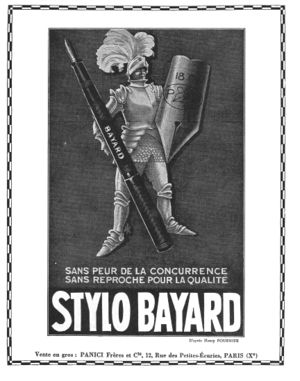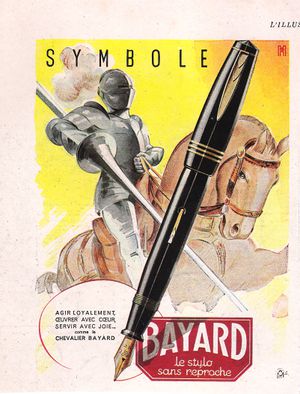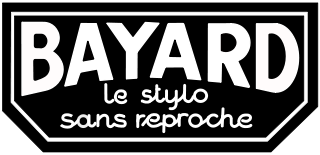Bayard
Bayard is a major historic French fountain pen brand; the company was founded in 1922 and has continued operations until the '60s when, as most historical producers, was taken down by the revolution of the ballpoint pen.
Bayard fountain pens were characterized by good overall quality, certainly in par with the one of the American producers, even though the company was never reported for specific innovative technical contributions, the validity of its products has ensured the success and is still valued by collectors.
| Bayard |
|---|
| Brand pages |
| Brand advertising |
| Brand photos |
| Instructions sheet |
| Other documents |
| Patents |
History

The company officially took the name Bayard only in 1934, when the Panic Frères & Co. was renamed in Stylo Bayard. The company had its origins in the late years of 1800, starting from the activities of a Parisian bookseller, Etienne Forbin, who in 1903 took the reselling rights of various American writing instruments producers. In 1912 he registered the trademark Bayard. In 1922 the Forbin grandchildrens resumed the work of their grandfather founding the Société Panic Frères and started a fountain pens production. But for marketing reasons, they used as trademark the name of the medieval knight Pierre Terrail de Bayard, that was an hero of the wars in the medieval Italy, considered as the image of the knight without fear and without blemish.
The initial models were the classic pens in chased or mottled hard rubber, made in cylindrical shapes with the classical eyedropper or safety filling system. There were also luxury models with gold or silver overlays. The pens were advertised using the figure of a knight who had a nib as a shield and a pen as a spear; the advertising claimed that the Bayard pens did not feared competition or remarks on their quality. The nibs of these first models were marked with the symbol PF (standing for Panici Frères) except for the top models that had the nib marked with the word Bayard, which otherwise was normally reported on the pen body.
In 1927 were first introduced lever filler models, that in 1930 were divided into two series, the Normal and the De Luxe. In the late '20s the company began to produce their firsts celluloid models, and launched the series '446, in jade, ruby and lapislazuli, with a special removable back that could be replaced to use the pen on a pen-holders table.
In 1932 production was reorganized, and an economic model, the Special 8 was launched; it was a lever filler, in black or marbled celluloid black with an metal alloy nib. It was then introduced the model Superluxe, always a lever filler, but with gold nib and produced in black, iridescent marbled gold or iridescent marbled green celluloid. The new pens had streamlined forms, with the ends of cap and body of conical shape, and were produced both men and woman models.
The next year another models reorganization was made, the Special 8 economic model was introduced, with a metallic. The pen had two ring on the cap and and black or marbled body; the same was for the Luxe and the Superluxe models that were coupled with it, but that were equipped with gold nibs. It was then introduced the Superluxe Grosse Containance model, with an increased size and bigger ink capacity, that had a decorated band on the cap. The Special 8 e Luxe models were provided with a tie-shaped clip inserted on the cap, while the Superluxe and Superluxe Grosse Containance had a spear-shaped washer clip. The next year the clip was engraved the name Bayard.
In 1935 the Superluxe cap rings were replaced by a decorated band. The clip of both this model and the Grosse Capacité (new name of Grosse Containance) model were built in the shape of a tie, but without the Bayard name engraving. In 1937 a model with an intermediate size between the Luxe and the Superluxe was introduced. It was called Special Luxe, and made by marbled colored celluloid, with the usual decorated band on the cap, which decoration was amended the following year. In 1939, following the trend introduced by the Vacumatic, Bayard introduced a new model equipped with transparent barrel to stem the ink level vision, called Niveauclair.
In that same period two other flagship sub-brands were also used directed towards two different market segments: the Excelsior brand for the second tier of medium quality pen production, and the Alpin brand used for cheaper pens produced for the lower end of the market, mainly students and schoolchildren.
In 1940 there was a restyling of the Luxe line going towards a more streamlined cap but maintaining the conical ends of the pen. It was also introduced the new Superstyl model, still a lever filler, in two versions for men and women. The Superstyl had three rings on the cap and a spear-shaped clip with a double "V" pattern; it was made of celluloid produced in many colors, and equipped with a gold nib. The next year the Super Luxe model was introduced, a cheaper and smaller pen, reiterating the lines of the Special 8, and aimed at young people.

The Second World War period was critical, as the use of gold was forbidden in many European country, and the celluloid supply began to run low. The company still tried to maintain high quality, while using steel nibs. Around 1943 was introduced the Excelsior model; it was very similar to the Superstyl, but with a steel nib branded with the Excelsior name. The innovative feature of this pen was that the whole nib block was interchangeable, since the steel nibs were subject to greater wear, and the pen was sold with a spare The model was successful, and despite the restrictions had disappeared after the war, it remained in production until 1948.
Nel 1947 vennero ristilizzati, seguendo le nuove tendenze d'oltreoceano, una serie di modelli di successo come la Special 8 e la Special Luxe e la 4. Nel 1949 venne introdotto anche un modello Superstyl ristilizzato, con una linea ancora più affusolata e senza la doppia "V" sul fermaglio, nello stesso anno l'azienda lanciò altri modelli: la Special Luxe, la Capostil con pennino coperto, ed una versione economica della Special 8, tutti con caricamento a levetta.
All'inizio degli anni '50 le linee stilistiche si uniformarono e le varie serie assunsero una forma più affine; si passò a modelli completamente affusolati perdendo le estremità coniche. Nel 1950 venne lanciato il modello di lusso Super Bayard, nello stesso periodo nacquero altri modelli come la Bayard 2000. Vennero anche prodotti alcuni modelli con caricamento a pompetta come l'Excelsior 507 o con caricamento a fisarmonica (il brevetto della Stylomine era ormai scaduto) come il modello Fit.
Nel prosieguo degli anni '50 l'azienda subì un continuo calo di vendite dovuto all'introduzione della penna a sfera; cercò il rilancio nel 1956 con il modello Souverain de Luxe, di forma affusolata, con pennino coperto e caricamento a fisarmonica, prodotto anche con cappuccio metallico. Ormai però il mercato degli strumenti da scrittura era dominato dalle penne a sfera; vennero introdotti modelli minori, come la Bayard 20, la Bayard 30 e la Karting a cartuccia, ma il declino proseguì inesorabile, fino alla definitiva chiusura a metà degli anni '70.
Template:CronoMarche |- | 1912 || registrato il marchio Bayard |- | 1922 || nasce la Panici Freres & Co |- | 1927 || introdotti i modelli con caricamento a levetta |- | 1929 ? || introdotta la celluloide e la serie 446 |- | 1932 || introdotte le serie Special 8 e Superluxe |- | 1933 || alle Special 8 e Superluxe si aggiungono la Luxe e la Superluxe Grosse Containance |- | 1934 || la Panici Freres & Co cambia nome in Stylo Bayard |- | 1934 || sulla clip viene inciso il nome Bayard |- | 1935 || sulla Superluxe viene adottata una veretta decorata |- | 1937 || la serie Luxe viene ribattezzata Special Luxe |- | 1938 || restiling della Special Luxe con una nuova veretta |- | 1939 || introdotto il modello Niveauclair a serbatoio trasparente |- | 1940 || introdotto il modello Superstyl |- | 1941 || introdotto il modello Super Luxe |- | 1943 || introdotto un modello Excelsior con gruppo pennino intercambiabile |- | 1947 || reintrodotte nuove versioni dei modelli Special 8, Special Luxe e la 4 |- | 1948 || dismesso il modello Excelsior |- | 1949 || ristilizzata la Superstyl, introdotta la Capostil e la Special 8 economica |- | 1950 || introdotto il modello di lusso Super Bayard |- | 1956 || introdotta la serie Souverain de Luxe |- | 1958 || la Souverain de Luxe adotta il caricamento a fisarmonica |- | 1973 || la Bayard cessa la produzione |- |}
Template:LegendaModelli |- | Special || 1932 || |- |}
Note
